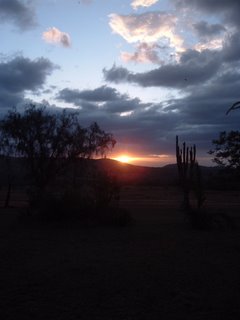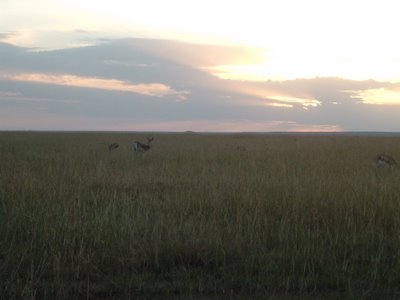
On Wednesday afternoon, I embarked on my first excursion outside of Nairobi, to a small town called Kitengela, which is located in Kajiado district in the Rift-Valley Province, about an hour south-east of Nairobi proper. Kitengela is noteworthy because it is the first major town on the southern border of Nairobi national park. Nairobi national park (to which I have not been just yet) is an extreme example of the fascinating pattern of suburbanization in Kenya that I was discussing
before- it is a 113 square kilometer area south of the city of Nairobi proper that is a Wildlife reserve. Just 20 minutes south of city center, you can see Zebras, Wildebeasts, and Lions- I can't think of any comparable phenomenon anywhere else in the world.

Kitengela's unique location right on the border of Nairobi National park makes it interesting and important for a number of reasons. First off, it is a rare and unique place for human-wildlife interactions. The park is not fully fenced in, but rather has an open lane to the south to allow for seasonal migrations; as a result its normal for farmers or pastoralists to see these animals roaming through their fields/grazing lands. However, because it is the first town outside of the park, Kitengela is experiencing MASSIVE population growth (which I’ll discuss more below) as a commuter town for Nairobi, meaning that development is starting encroach on the lane that has been traditionally allowed for the migration, leading to an increase in what experts call "human-wildlife conflict", or what I would call "various and sundry maulings and tramplings".
The lack of planning to manage wildlife, agricultural, and pastoral land use is indicative of broader problems of governance and resource management in Kitengela. Early in the 20th century, Kitengela (and Kajiado province more broadly) were primarily inhabited by
Maasai pastoralist communities. Although it could be a whole other series of posts, it is worth noting that this territorial pattern was itself a result of a series of
broken treaties and forced moves during the early stages of British rule-sound familiar to any episodes from American history?
According to numerous sources, Maasai land tenure during the colonial period was collective; although individual familes owned their own cattle, all Maasai were able to access grazing land on their reserve, an institutional arrangement that many agricultural economists have recognized as a strategy to manage and mitigate risk in environments in which rainfall is highly variable. At independence, the Kenyan government formalized a form of joint property ownership, in the form of group ranches. Upon the enactment of the land settlement in 1968, families joined one of these ranches-which frequently approximated customary lands as held by clans and lineages, the major difference being that there were to be rigid boundaries between group ranches. Thus, even though families could graze their cattle anywhere on the land of the group ranch of which they were a member, they could also ONLY graze their cattle on that land, a strong break from the prior system, in which rights to land use were collective AND overlapping. In addition, individuals or families who did not join a group ranch were given a single ranch. Often these farmers were supported heavily with subsidies by the ruling party; its unclear whether they were transplanted urbanites with connections to the ruling party as described by Robert Bates in
"States and Markets in Tropical Africa".
An additional feature of the group ranch plan that is of vital importance for what is happening in Kitengela right now is that there is a clause in the law that created the group ranches that allows for the possibility of the dissolution of the ranch and its subdivision into individual plots. For a variety of reasons, there a was a wave of subdivision throughout Kajaido district in the 1980s, which led in turn to the widespread sale of individual plots, and the rush of development I was describing above. This expansion has happened so rapidly that it has gone forward largely unplanned; residential, commercial, industrial, and agricultural units are all jumbled together in one haphazard heap. For instance, the slaughterhouse, which used to be on the outskirts of town, is now completely surrounded by houses.

Many aspects of the layout of the town of Kitengela reminded me of images I’ve seen of the American West in the 19th century: buildings cropping up at odd angles, a hogepodge of new buildings that have sprung up around an only slightly older city center, dusty, crooked, unpaved roads, covered with piles of assorted garbage, and livestock wandering just blocks from the main commercial area. At the same time the contents of the garbage served as reminders of the distinctly modern nature of the pollution; coca-cola bottles were among the smashed bits of glass in the street; many of the trees around time were filled with tangles of discarded plastic shopping bags.

According to Joseph, a Kitengela resident who was my guide for the day, both the proliferation of trash and the lack of any kind of zoning or planning are the result of failures on the part of the local government; according to him, both problems have appeared roughly following the moves to subdivision in the 1980s. As Joseph described (and my prior reading had indicated) the traditional structure of Maasai local governance was structured by a combination of clans and age-sets. Both of these were relatively apparent to some degree just by observing the extent to which Joseph seemed to know everyone we came across in our walking tour; it seemed that we couldn’t turn a corner without running to someone whom he he knew. We also ran into both his mother and his father and two of his brothers, all of whom live in town.
When I remarked to Joseph that he seemed to be quite well-connected in town, he shrugged and said that things had changed a lot; compared to when he was young (in the early 80s), there are non-maaasai, meaning that they have by and large not been assimilated into Maasai social networks. At one point we were passed by a pair of young toughs (one of whom was carrying a crowbar and Joseph remarked, “You see these guys- I don’t know them- if they would have done something to us, we wouldn’t have been able to do anything about it- they’re strangers.”

What I take from all of this is that the clan and age set systems played a role in Maasai society similar to the Law Merchants in the Champagne Fairs described by North, Weingast, and Grief. Without taking another massive detour into the Political Economy field examination reading list, the gist is that institutions that allow for the sharing of information can promote social cooperation among reasonably large groups of people, even in the absence of a strong state. In the Kitengela of Joseph’s youth, nearly all of individuals in the town were connected via a dense network of kinship and clan linkages, as well as cross-cutting age set relationships. In such an interlinked community, a separate police force is in some ways superfluous; individuals who litter, steal, or do other socially undesirable things can be easily identified and shunned (Bates provides a similar analysis of the Nuer in his “Essays on the Political Economy of Rural Africa). As the percentage of people in the town who are part of these networks decreases, the efficacy of these institutions will decrease. Thus, whereas a lack of state presence was not a big deal (and was in fact rather desirable to many Maasai) during the 1970s, the rapid population growth has made the status quo untenable, leading to a massive surge in pollution, crime, and unplanned urban growth. Without some kind of institutional innovation, a reversal doesn’t seem likely, leaving Kitengela’s future rather uncertain.
This set of problems facing Kitengela convinces me that what I’m here to study is important and worth studying, while at the same time revealing that actually solving these problems is exceedingly difficult. While talking to Joseph and walking around Kitengela certainly affirmed some of my impressions and intuitions, it also made me realize that as soon as you step out of the library and into the field, things stop being as analytically neat as you’d like them to be. Yet, even though thinking about “specialists in violence”, “collective action problems”, and “the Weingast paradox” seems a little silly when you’re standing in the midst of piles of trash with the wind blowing dirt from the street all around you, it as also clear that the need to answer the questions that these concepts are designed to address is no less salient.

















































